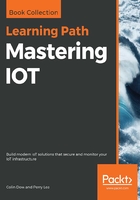
Bluetooth mesh addressing modes
Bluetooth mesh uses three forms of addressing:
- Unicast addressing: Uniquely identifies a single element in the mesh. The address is assigned during the provisioning process.
- Group addressing: This is a form of multicast addressing that can represent one or more elements. These are either predefined by the Bluetooth SID as SIG fixed group addresses or assigned on the fly.
- Virtual addressing: An address can be assigned to more than one node and more than one element. Virtual addressing uses a 128-bit UUID. The intent is the UUID can be preset by a manufacturer to allow them to address their product globally.
The Bluetooth mesh protocol starts with 384-byte long messages that are segmented into 11-byte parcels. All communication in a Bluetooth mesh is message-orientated. There are two forms of messages that can be transmitted:
- Acknowledged messages: These require a response from node(s) that receive the message. The acknowledgment also includes data that the originator requested in the original message. Therefore, this acknowledged message serves dual purposes.
- Unacknowledged messages: These do not require a response from the receiver.
To send a message from a node is also known as publishing. Nodes configured to process select messages sent to particular addresses is termed subscribing. Each message is encrypted and authenticated using a network key and an application key.
The application key is particular to an app or use case (for example, turning a light on versus configuring the color of an LED light). Nodes will publish events (light switches) other nodes will subscribe to those events (lamps and lightbulbs). The following figure illustrates a Bluetooth mesh topology. Here, nodes can subscribe to multiple events (lobby lights and hallway lights). The circles represent group addresses. A switch would publish to a group.

Bluetooth mesh introduces the concept of group messaging. In a mesh, you may have a grouping of similar objects such as bath lights or lobby lights. This aids in usability; for example, if a new light is added, only that light needs to be provisioned, and the rest of the mesh doesn't need any change.
The light switches in the preceding example have two states: on and off. Bluetooth mesh defines states and in this case, they are labeled generic OnOff. Generic states and messages support many types of devices from lights to fans to actuators. They are a quick way to reuse a model for a general (or generic) purpose. As the system moves from one state to another, this is termed a state transition on the mesh. States can also be bound to each other. If a state changes, it can affect the transition to another state. As an example, a mesh controlling a ceiling fan may have a speed control state which, when it gets to a value of zero, changes the generic On-Off state to off.
Properties are similar to states but have more than binary values. For example, a temperature sensor may have a state Temperature 8 to signify and publish an eight-bit temperature value. A property can either be set as manufacturer (read-only) by the supplier of the element or admin, which allows read-write access. Both states and properties are communicated through messages on the mesh. Messages come in three types:
- Get: Requests a value of a given state from one or more nodes
- Set: Changes a value of a state
- Status: Is a response to a get that contains the data
All of these concepts of states and properties ultimately form a model (the highest level of the Bluetooth mesh stack). A model can be a server, in which case it defines states and state transitions. Alternatively, a model can be a client which doesn't define any states; rather, it defines state interaction messages to use with get, set, and status. A control model can support a hybrid of server and client models.
Mesh networking can also make use of Bluetooth 5 standard features such as anonymous advertisements and multiple advertisement sets. Take the case of a mesh that connects to a phone for voice communication, yet simultaneously is relaying packets for other uses. By using multiple advertisement sets, both use cases can be managed simultaneously.